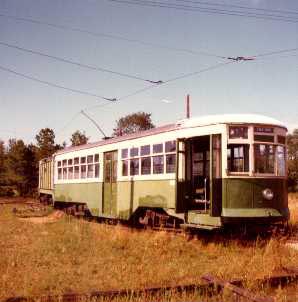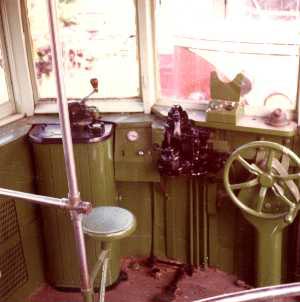
8042 - Historic Background
Car 8042 was ordered in 1923 by the Philadelphia Rapid Transit Company (PRT) as one of 385 single-end passenger cars, 135 double-end passenger cars and a sizable fleet of utility cars, including cranes, plows, sweepers and other miscellaneous types from the J G Brill Company, also of Philadelphia. This order represented the largest single order for surface passenger equipment ever let at one time and kept the Brill plant busy for most of the year. Furthermore, the Brill Company was regarded at the time as being one of the largest producers of electric vehicles in the world. Car 8042 was delivered to PRT in September 1923. An additional 100 single-end cars were ordered in December 1924 for 1925 delivery, followed by 50 single-end cars ordered in 1926 for use serving the Sesquicentennial Exposition. The 535 1923-1926 single-end cars were numbered 8000 through 8534 and were commonly referred to as 8000's (eighty-hundreds).
The 8000's were an update to the 1911-1913 Near-Side cars. The Near-Side car was the first major attempt to construct a lightweight high-capacity car. It was also one of the largest uses of arch roof instead of clerestory roof construction and foreshadowed later developments in these lines in the 1920's. The single-end Near-Side cars originally had only front entrance and exit doors with the conductor stationed immediately behind the motorman in the front of the car. Older double-end cars with the conductor stationed at the rear of the car would usually stop at the far side of an intersection to allow prospective passengers to board the rear of the car. Lines equipped with the new cars had the stops re-located to the near side of the intersection where the car was stopped and the front entrance and exit doors operated by the motorman, thus the name Near-Side cars. Unfortunately, the "muzzle loading" aspect of cars with only a front entrance and exit produced serious congestion on heavy passenger traffic lines. The solution was the installation of center exit doors and moving the conductor to a booth just in front of the center exit. Cars using this system are referred to as "Peter Witt" cars after the transit company official in Cleveland, Ohio who developed it.
All of the 8000's were equipped with Brill 39E2 trucks, two General Electric (GE) #275 motors, GE K68 controllers and center exit doors. The Brill 39E2 trucks, like the Brill 39E trucks on the Near-Side cars, have one powered axle equipped with a large diameter wheel and an idler axle with a smaller diameter wheel on each truck. The truck bolster is offset towards the powered axle. This "maximum traction" arrangement was an attempt to transfer as much of the car weight as possible to the powered axle. Because of the more modern #275 motors on the 8000's the powered axle was 28" in diameter, as compared to the 33" diameter of the Near-Side car, thus providing a slightly lower interior floor height. The idler axle had a 22" wheel on both car series.
The 8000 incorporated many advances in design and construction over the older cars used in Philadelphia. Differences from the older type cars are a greater use of lightweight steel construction as an alternative to the composite steel and wood or all wood framing construction, center exits with sliding doors and an interior step well as an alternative to the use of folding center doors and steps that created clearance problems on narrow streets, and a truck center bearing mounting that was slightly offset from the centerline to compensate for the greater weight on the one side of single-end cars.
As were all Philadelphia streetcars, the Brill 39E2 trucks were built to a wide gauge of 5 feet, 2-1/4 inches. This wide gauge of 5 feet, 2-1/4 or 5 feet, 2-1/2 inches between the running rails is often referred to as Pennsylvania Broad Gauge because of its extensive use in most Pennsylvania cities. Exceptions such as Scranton and Allentown used standard railroad gauge of 4 feet, 8-1/2 inches, however.
All of the 8000's were equipped with center exits and a conductor's booth for Peter Witt type operation. They were also equipped with safety type control equipment and could be operated by one man. Many of the cars were delivered with an unusual turnstile arrangement at the center door which permitted passengers to enter or exit through that door at the discretion of the operator. The operator would then collect fares at the front door, either as passengers entered or alighted, according to the operating mode in effect on the route at the moment. The cars so equipped, 8042 among them, were classified A-18 by PRT. This idea did not prove too practical and the turnstiles were removed in 1924, the center exit sealed and the car operated in the same manner as the original Near-Side car, but with one man on lightly patronized lines.
In 1940, the PRT, which was in receivership, was reorganized as the Philadelphia Transportation Company (PTC). A general program of rehabilitation was undertaken. Older cars were starting to be retired with the delivery of new streamlined PCC cars, trackless trolleys and motor buses. The remaining 668 (8000s and 5200s) cars that were ordered in 1923 to 1926 were targeted for modernization. The modernization program included equipping the cars with:
The management applied a new paint scheme using a brighter shade of green than was common to PRT cars and inspired by the PCC cars, added a set of wings around the headlights of the 8000's and christened the cars "Paintliners" for publicity purposes. The paint scheme also featured a silver roof and letterboard area, an ivory-cream window area and thin bright red stripes to accent the color changes above and below the window lines. The Traction Heritage reprint of a 1940 Transit Journal article by R. F. Tyson, Vice President, Operation, Philadelphia Transportation Company provides additional information.
Between October and November of 1940 all 50 of the 1926 cars were modernized, being equipped for either one or two man operation. Between November 1940 and October 1941, 137 of the 1923 8000's were also modernized as one man/two man cars and an additional 86 cars were modernized and remodeled for one man use only. The conductor booths were removed and the seating capacity increased through the installation of an extension to the longitudinal seat on the right side of the car. Car 8042 was included with this group. Sixteen of the 1923 double end cars were similarly modernized in October 1940 with a modification to the destination sign location and a slightly different, simpler design for the headlight wing. World War II halted the program when, in desperate need for more cars, the PTC shops began restoring to service old Hog Island and Near-Side cars that were in storage. The program was never resumed after the war ended.
This photograph of car 8082 by Joseph M. Mannix at 63rd Street near Lancaster Avenue, Philadelphia shows a sister car to 8042 shortly after the "Paintliner" modernization was made.

The modernized 8000's were primarily used on Market Street in Philadelphia, both on the subway surface lines to West Philadelphia and the surface lines to North, South and West Philadelphia. In later years the "Paintliner" color scheme was simplified to a gray roof, with the letterboard and window area the ivory-cream and a medium bus green below the belt rail. The last of these cars were removed from service in December 1957.
Car 8042 was originally purchased from the PTC by the Metropolitan Philadelphia Railway Association and moved to the Delaware Valley Short Line museum site in Tansboro, New Jersey. The car was then purchased by Earl T. Johnston, Jr., now a principal in the Transquip Company. The late Robert Borzell, a Philadelphia Park Guard Officer and long time member of the Buckingham Valley Trolley Association and predecessor groups later purchased 8042 from Mr. Johnston.
These photographs of car 8042 were taken by Alan Trachtenberg at the Tansboro, New Jersey location in 1972.

![]()

Car 8042 was chosen for preservation because it was the last car to operate on the York Road to Willow Grove line (Route 55) on September 8, 1940. All of the cars in service on Route 55 at the time of its conversion were sent to Kensington Shop for overhaul due to the poor condition of Route 55's roadside trackage, which badly racked the frames of these cars. These cars were all remodeled into the "Paintliner" scheme and assigned to subway surface lines.
For display at the Electric City Museum, the original 1940-41 "Paintliner" color scheme has been selected for 8042. This display will illustrate how a utilitarian 1920's streetcar was updated by a transit operator to present a more attractive appearance to the public. There are two other 8000's that have been preserved. No. 8534, leased and utilized by the Southeastern Pennsylvania Transportation Authority (SEPTA) for charter trips and special events, has been substantially backdated to its original 1926 PRT appearance. No. 8530, privately owned in Central Pennsylvania, retains the simplified colors of a modernized PTC car at the end of service in 1957.
References:
Surface Cars of Philadelphia 1911-1965, Harold E. Cox, Forty Fort, Pennsylvania
BVTA Newsletter, May 1984, Article by Joseph M. Mannix